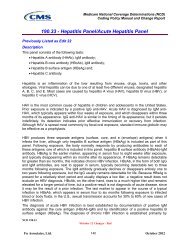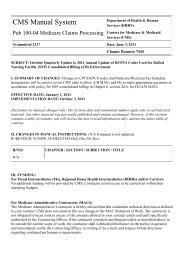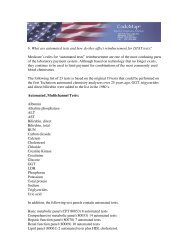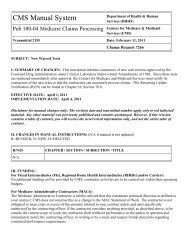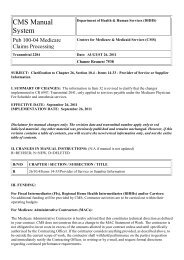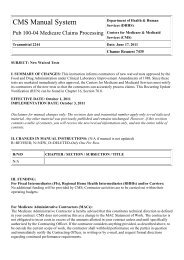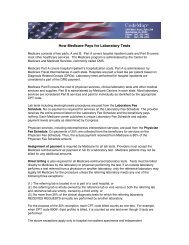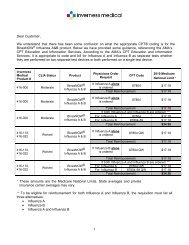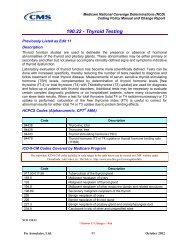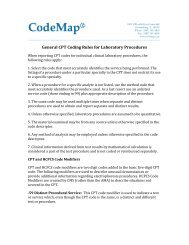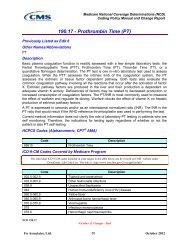NCD 190.13 - CodeMap
NCD 190.13 - CodeMap
NCD 190.13 - CodeMap
Create successful ePaper yourself
Turn your PDF publications into a flip-book with our unique Google optimized e-Paper software.
This is CMS Logo.<br />
Medicare National Coverage Determinations (<strong>NCD</strong>)<br />
Coding Policy Manual and Change Report<br />
<strong>190.13</strong> - Human Immunodeficiency Virus (HIV)Testing<br />
(Prognosis Including Monitoring)<br />
Previously Listed as Edit 2<br />
Other Names/Abbreviations<br />
HIV-1 or HIV-2 quantification or viral load<br />
Description<br />
HIV quantification is achieved through the use of a number of different assays which measure<br />
the amount of circulating viral RNA. Assays vary both in methods used to detect viral RNA as<br />
well as in ability to detect viral levels at lower limits. However, all employ some type of nucleic<br />
acid amplification technique to enhance sensitivity, and results are expressed as the HIV copy<br />
number.<br />
Quantification assays of HIV plasma RNA are used prognostically to assess relative risk for<br />
disease progression and predict time to death, as well as to assess efficacy of anti-retroviral<br />
therapies over time.<br />
HIV quantification is often performed together with CD4+ T cell counts which provide<br />
information on extent of HIV induced immune system damage already incurred.<br />
HCPCS Codes (Alphanumeric, CPT AMA)<br />
Code<br />
Description<br />
87536 Infectious agent detection by nucleic acid (DNA or RNA); HIV-1,<br />
quantification<br />
87539 Infectious agent detection by nucleic acid (DNA or RNA); HIV-2,<br />
quantification<br />
ICD-9-CM Codes Covered by Medicare Program<br />
The individual ICD-9-CM codes included in code ranges in the table below can be viewed on CMS’ website under<br />
Downloads: Lab Code List. The link is: http://www.cms.hhs.gov/CoverageGenInfo<br />
Code<br />
Description<br />
042 Human immunodeficiency virus [HIV] disease<br />
079.53 Human immunodeficiency virus, type 2 [HIV-2]<br />
647.60-647.64 Other viral diseases complicating pregnancy (including HIV-I and II)<br />
795.71 Nonspecific serologic evidence of human immunodeficiency virus [HIV<br />
V08<br />
Asymptomatic human immunodeficiency virus [HIV] infection status<br />
Indications<br />
1. A plasma HIV RNA baseline level may be medically necessary in any patient with<br />
confirmed HIV infection.<br />
<strong>NCD</strong> <strong>190.13</strong><br />
*October 12 Changes – Red<br />
Fu Associates, Ltd. 18 October 2012
This is CMS Logo.<br />
Medicare National Coverage Determinations (<strong>NCD</strong>)<br />
Coding Policy Manual and Change Report<br />
2. Regular periodic measurement of plasma HIV RNA levels may be medically necessary<br />
to determine risk for disease progression in an HIV-infected individual and to determine<br />
when to initiate anti-retroviral treatment regimens.<br />
3. In clinical situations where risk of HIV infection is significant and initiation of therapy is<br />
anticipated, a baseline HIV quantification may be performed. These situations include:<br />
Limitations<br />
a. Persistence of borderline or equivocal serologic reactivity in an at-risk individual.<br />
b. Signs and symptoms of acute retroviral syndrome characterized by fever, malaise,<br />
lymphadenopathy and rash in an at-risk individual.<br />
1. Viral quantification may be appropriate for prognostic use including baseline<br />
determination, periodic monitoring, and monitoring of response to therapy. Use as a<br />
diagnostic test method is not indicated.<br />
2. Measurement of plasma HIV RNA levels should be performed at the time of<br />
establishment of an HIV infection diagnosis. For an accurate baseline, 2 specimens in<br />
a 2-week period are appropriate.<br />
3. For prognosis including anti-retroviral therapy monitoring, regular, periodic<br />
measurements are appropriate. The frequency of viral load testing should be<br />
consistent with the most current Centers for Disease Control and Prevention guidelines<br />
for use of anti-retroviral agents in adults and adolescents or pediatrics.<br />
4. Because differences in absolute HIV copy number are known to occur using different<br />
assays, plasma HIV RNA levels should be measured by the same analytical method. A<br />
change in assay method may necessitate re-establishment of a baseline.<br />
5. Nucleic acid quantification techniques are representative of rapidly emerging &<br />
evolving new technologies. Users advised to remain current on FDA-approval status.<br />
ICD-9-CM Codes That Do Not Support Medical Necessity<br />
Any ICD-9-CM code not listed in either of the ICD-9-CM covered or non-covered sections.<br />
Other Comments<br />
Assessment of CD4+ T cell numbers is frequently performed in conjunction with viral load<br />
determination. When used in concert, the accuracy with which the risk for disease progression<br />
and death can be predicted is enhanced.<br />
Sources of Information<br />
CDC.1998. Guidelines for the use of antiretroviral agents in HIV-infected adults and<br />
adolescents. MMWR 47 (RR-5).<br />
CDC.1998. Guidelines for use of antiretroviral agents in pediatric HIV infection. MMWR47 RR-4.<br />
CDC.1998. Public Health Service Task Force recommendations for the use of anti-retroviral<br />
drugs in pregnant women infected with HIV-1 for maternal health and for reducing perinatal HIV-<br />
1 transmission in the United States. MMWR 47 (RR-2).<br />
Carpenter, C.C., M.A. Fischi, S.M. Hammer, et . al. 1998. Antiretroviral therapy for HIV infection<br />
in 1998. Updated recommendations of international AIDS society-USA panel. A.M.A. 280:78-86.<br />
Saag, M.S., M. Holodniy, D.R. Kuritzkes, et al. 1996. HIV viral load markers in clinical practice.<br />
Nature Medicine 2(6): 625-629.<br />
<strong>NCD</strong> <strong>190.13</strong><br />
*October 12 Changes – Red<br />
Fu Associates, Ltd. 19 October 2012



